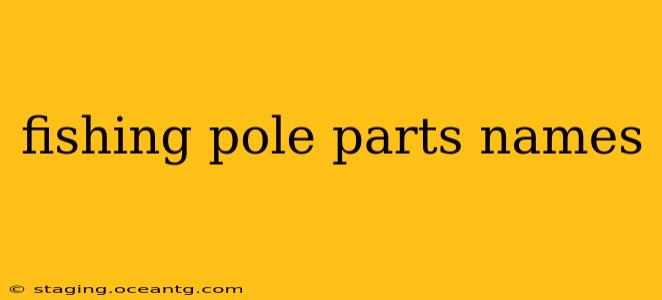Fishing enthusiasts, whether seasoned anglers or beginners just starting their journey, need to understand the different parts of a fishing pole. Knowing these parts not only helps with assembly and maintenance but also allows for more informed choices when selecting the right equipment. This guide dives deep into the anatomy of a fishing pole, explaining each part's function and significance. We'll also address some frequently asked questions to ensure you're completely equipped with knowledge.
Major Components of a Fishing Rod
A fishing rod, regardless of its type (spinning, casting, fly fishing, etc.), generally consists of these key components:
-
Tip: The very end of the rod, often the thinnest and most delicate part. It's the first point of contact with the line and plays a crucial role in detecting subtle bites.
-
Tip-Top (or Tip Guide): A small ring or guide located at the very tip of the rod. It guides the fishing line smoothly as it is cast and retrieved. Different materials (like ceramic or stainless steel) offer varying levels of durability and smoothness.
-
Guides (or Line Guides): These are the rings along the rod's blank that the fishing line passes through. They reduce friction during casting and retrieving, allowing for longer casts and smoother operation. Their size and spacing are critical for proper line management.
-
Rod Blank: This is the main body of the rod, usually made of fiberglass, graphite, or a composite material. The blank's material determines the rod's strength, flexibility, and action (how it bends when under load).
-
Reel Seat: This is the part of the rod where the fishing reel attaches. Its design varies greatly depending on the type of rod and reel being used. A secure reel seat is essential for preventing the reel from slipping or coming loose.
-
Butt: The thickest part of the rod, located at the handle end. It provides the angler with a solid grip and leverage during the fight with a fish.
-
Handle (or Grip): The section of the rod you hold. This can be made of cork, foam, rubber, or other materials, each providing a different level of comfort and grip.
Types of Fishing Rod Handles and Their Materials
Different handle materials offer distinct advantages and disadvantages:
-
Cork: Offers excellent grip and feel, often considered a premium material. However, cork can be more expensive and requires more maintenance.
-
EVA Foam: A popular choice for its durability, lightweight nature, and affordability. Provides good grip, even in wet conditions.
-
Rubber: Durable and often inexpensive, but might not offer the same level of sensitivity or comfort as cork or EVA foam.
What are the Different Types of Fishing Rods?
The type of fishing rod you use significantly impacts your fishing experience. Common types include:
-
Spinning Rods: Designed for spinning reels and lighter lures or baits. They are versatile and popular for a wide range of fishing applications.
-
Casting Rods: Used with baitcasting reels and are often preferred for heavier lures and baits, particularly in bass fishing.
-
Fly Rods: Specialized rods used for fly fishing, characterized by their flexible nature and lightweight design.
-
Spincasting Rods: A simpler type of rod often used with spincasting reels and is a good option for beginners.
What is the difference between a rod’s action and power?
-
Rod Action: This refers to how the rod bends under pressure. Fast action rods bend primarily in the tip, while slow action rods bend along their entire length.
-
Rod Power: This refers to the rod's strength and its ability to handle heavier lures and fish. Power ratings range from ultra-light to extra-heavy.
How do I choose the right fishing rod?
Choosing the right fishing rod depends on several factors, including the type of fish you're targeting, the type of bait or lure you'll be using, and your personal preferences. Consider the rod's length, action, power, and material when making your selection.
This comprehensive guide provides a thorough understanding of fishing pole parts and related concepts. Remember to carefully consider your fishing needs when selecting your equipment. Happy fishing!
